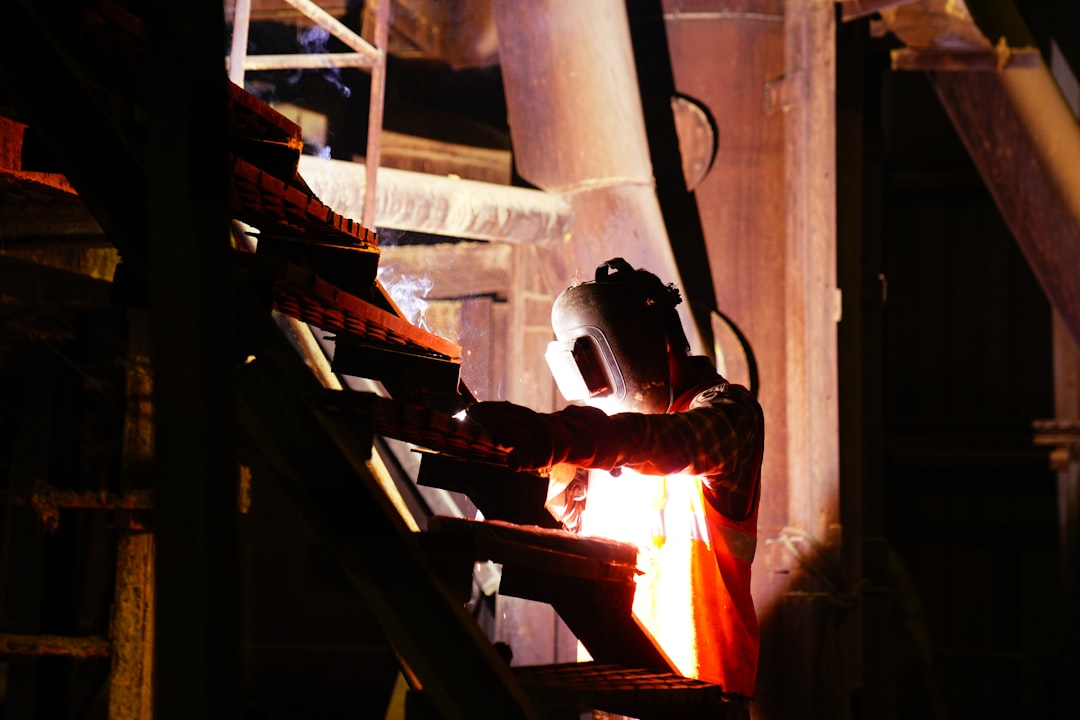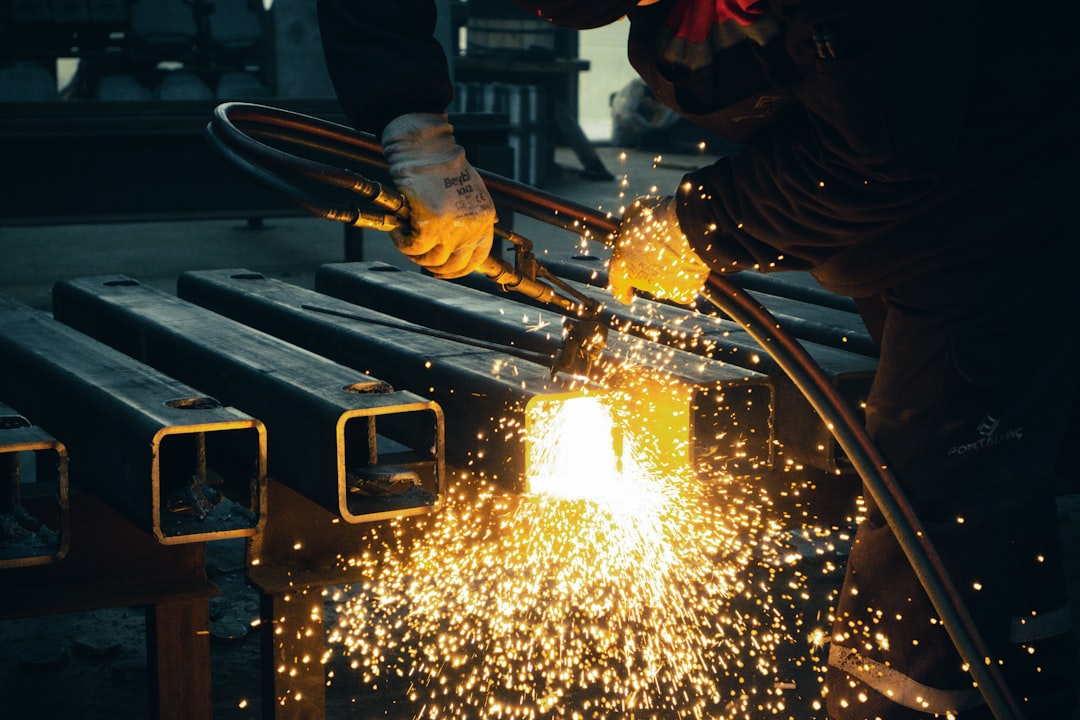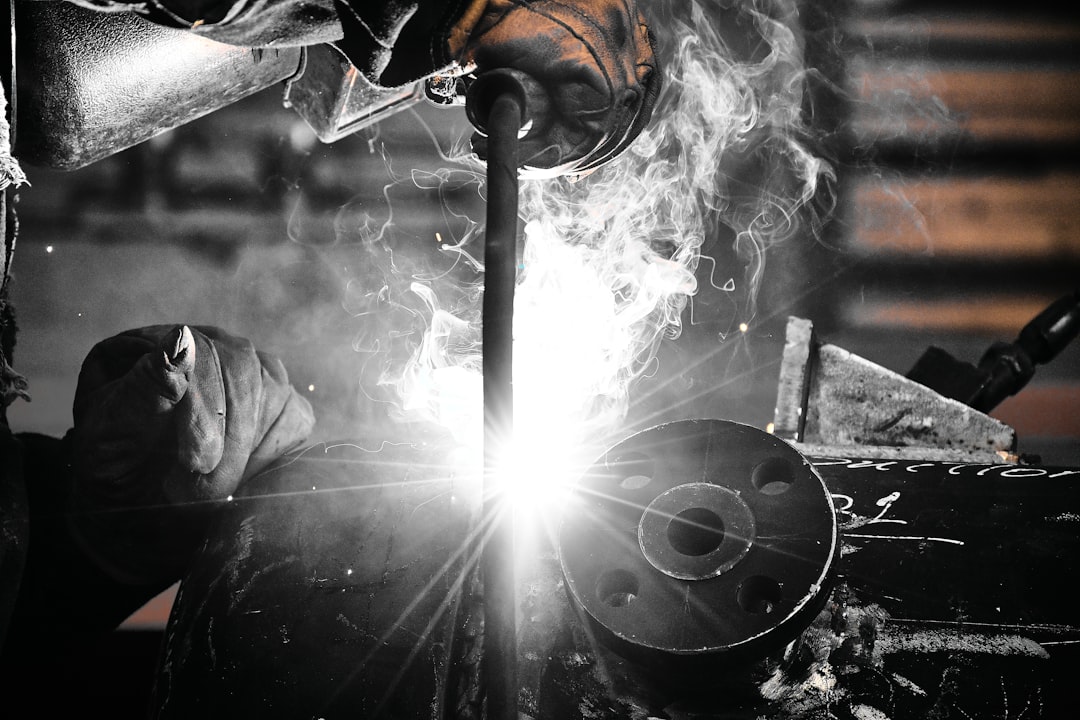

Engage prospects with a scan and streamline customer engagement with FREE QR code marketing tools by Sona – no strings attached!
Create a Free QR CodeFree consultation

No commitment

Engage prospects with a scan and streamline customer engagement with FREE QR code marketing tools by Sona – no strings attached!
Create a Free QR CodeFree consultation

No commitment
Steel fabrication companies are navigating a rapidly changing landscape where clients demand both precision workmanship and seamless project communication. Yet, many firms remain burdened by outdated paper-based processes, static brochures, and labor-intensive onboarding, often resulting in missing out on high-value prospects who engage but never formally submit contact details. This disconnect leads to lost opportunities, incomplete records, and inefficient workflows that slow down response times and hinder project delivery. As digital transformation accelerates in the construction and industrial sectors, the need to connect physical and digital experiences has never been more urgent.
QR codes offer a frictionless bridge between the offline and online worlds, giving steel fabrication companies an efficient way to deliver instant access to critical documents, certifications, project updates, service requests, and more with a single scan, no app required. Strategic QR integration into print collateral, project signage, equipment tags, and other touchpoints addresses the pervasive pain of invisible or anonymous user traffic, enabling real-time visibility into every engagement that previously slipped through the cracks. By doing so, companies can streamline customer journeys, surface leads who might otherwise remain untracked, and gain actionable insights to refine project communication and sales follow-up. For an overview of adoption and campaigns, see QR codes in marketing.
This guide shows how steel fabrication companies can use QR codes to modernize engagement, optimize lead capture, and differentiate in a highly competitive market. Learn how to leverage this technology to drive real-world business outcomes, from enhancing project transparency and personalizing follow-ups for previously anonymous interest to improving client communication and automating compliance workflows for faster and more accurate reporting.

Steel fabrication companies face rising pressures to deliver timely updates, detailed documentation, and robust customer support, all while reducing administrative burdens and ensuring that no key opportunity is missed. A frequent challenge is the inability to identify or track prospect and client engagement at key analog touchpoints, which results in incomplete account data and leaves valuable leads untapped. QR codes make it possible to digitize everything from equipment manuals and inspection reports to safety training and live project dashboards, converting previously static or anonymous interactions into actionable data.
The most effective approach starts by mapping current analog processes, then systematically replacing them with QR-enabled experiences that collect context, accelerate access, and trigger follow-up. Replace printed brochures with scannable digital catalogs, paper RFQs with mobile-friendly forms built via Google Forms, and manual sign-in sheets with trackable digital check-ins. Once these on-ramps exist, you can measure which moments of engagement correlate with conversions, service requests, or compliance milestones, and invest accordingly.
These workflows replace static handouts and manual data entry with streamlined, self-serve digital experiences that amplify efficiency, transparency, and the capture of high-value prospects who might otherwise remain off the radar. Modern platforms like Sona QR can automate scan tracking, intent capture, and CRM syncing, instantly routing new interactions into the right sales or service workflows and closing common gaps in lead management.
By starting small and iterating quickly, teams can build confidence, prove ROI, and scale across the entire operation. As more documents, checkpoints, and service requests move from paper to QR-enabled flows, the cumulative gains add up: less time chasing paperwork, faster approvals, and a single source of truth for engagement insights that inform production, logistics, and account management.

Steel fabrication companies rely on a mix of on-site operations, printed documentation, and one-to-one communication, all of which can lead to critical engagement signals being missed or untracked when relying solely on paper-based systems. For instance, when high demo interest is shown during facility tours or in response to marketing collateral but visitors never fill out a form or formally request more information, the opportunity to nurture or convert that lead is lost. QR codes disrupt this pattern by providing an easy, low-friction gateway for prospects and customers to interact with your content wherever they encounter it.
Adding QR codes to delivery tickets for material certifications, shop floor signage for safety guidelines, or QR-enabled steel QR tags instantly digitizes traditionally opaque workflows. In doing so, fabricators gain new data on who is engaging, when, and with what resources. That visibility makes it possible to personalize follow-ups, trigger relevant retargeting campaigns, or even automate compliance confirmation. The result is not just convenience, but strategic intelligence about buyer readiness, project progression, and service needs that would otherwise remain hidden.
Together, these advantages create a modern operating cadence where information is both accessible and measurable. Fabricators can prove which campaigns, documents, or placements move the needle, and reallocate resources to the work that drives safety, compliance, and revenue outcomes.

Different QR formats fit different objectives. Steel fabrication teams should select formats that match the action they want a scanner to take, and the system they need to connect to. While most scenarios start with simple web links, other formats like vCards or forms can reduce friction and increase the quality of data you capture.
A key decision is whether to use static or dynamic QR codes. Static codes are fine for unchanging destinations like a permanent safety policy. Dynamic codes are better for evolving content, campaign analytics, and audience segmentation. With a platform like Sona QR, you can generate both types, change destinations without reprinting, and centralize management and reporting.
Dynamic QR codes allow managers to update landing URLs as projects progress, ensuring end users always have the latest information and avoiding confusion from outdated printouts. Static codes are best for fixed-use scenarios such as facility Wi-Fi or evergreen safety protocols. Centralized QR management helps audit usage, update destinations, and correct issues so incomplete data no longer hampers follow-up or compliance.
Physical interactions on the plant floor, at client sites, and within delivery workflows often escape digital tracking. When those moments are not captured, valuable signals about demand, satisfaction, and risk remain invisible. QR codes placed thoughtfully convert these offline moments into measurable digital actions, revealing opportunities to retain, upsell, and serve clients better.
Start by identifying the printed items and physical surfaces that clients already engage with, then add QR codes that answer a specific need. Clear CTAs next to each code make the value proposition explicit, and dynamic destinations keep content fresh as project details change.
By turning every channel into a two-way, trackable interaction, fabricators uncover revenue signals that were previously hidden. That intelligence powers retargeting, reduces churn, and helps sales teams prioritize accounts showing timely, meaningful activity.

QR-enabled workflows tackle visibility gaps across documentation, certifications, and service channels. They make it easier for teams and clients to find what they need, when they need it, while ensuring your organization captures the engagement data required for timely follow-up and compliance.
Deploy a handful of high-impact use cases first, measure lift, and then scale. As adoption grows, standardize code design, CTA language, and data capture policies so the experience feels cohesive across every touchpoint.
When combined with dynamic destinations and CRM integration through platforms like Sona QR, these use cases create a closed loop: you know who scanned, what they wanted, and what happened next. That visibility powers faster responses, better customer experiences, and measurable ROI.
Every QR code scan on your materials is a signal of purchase intent, knowledge gaps, or upsell readiness. Many companies fail to capture and act on this engagement due to incomplete account data or disconnected systems. By grouping scans by context, channel, and timing, you can create powerful audience segments that fuel precise retargeting and automated follow-up. To refine messaging by behavior, ground your approach in intent data.
In steel fabrication, audience distinctions often include general contractors and construction managers, procurement teams, inspectors, and end clients. Each group interacts with different content for different reasons. Segmentation lets you tailor messaging and offers, which increases relevance and response.
By retargeting based on real behavior rather than assumptions, you can run smaller, smarter campaigns that cost less and convert more. Over time, your audience model will reflect actual project lifecycles and purchase patterns, making your marketing and sales motions significantly more efficient.
QR codes are the connective tissue between offline materials and digital systems. They make print media measurable, events actionable, and service workflows predictable. For steel fabricators, this connectivity is particularly valuable because much of the buyer journey unfolds across yards, shops, and jobsites where laptops are not always available.
Treat QR codes as an always-on entry point to your brand. Standardize design, use consistent CTAs, and centralize management so that every scan feeds the same data pipeline. The result is a cohesive multichannel strategy that increases engagement while simplifying internal operations.
A centralized QR system such as Sona QR ensures consistent branding, eliminates dead links, and syncs all channels back into your CRM for accurate attribution. That closed loop allows you to adjust campaigns in real time based on what the data shows and to attribute revenue back to the physical touchpoints that drove action.
Rolling out QR codes successfully is a mix of strategy and execution. You need clear goals, the right formats, thoughtful design, and a process for monitoring and optimizing. When those elements align, QR becomes a reliable growth lever and an operational advantage across your plant and project sites.
Use the following checklist to plan and launch your QR initiatives. It is designed to align with the realities of steel fabrication environments where surfaces are textured, lighting varies, and workers are often gloved or on the move. Small design choices and placement decisions significantly affect performance, so test and iterate before scaling.
Select one high-impact problem to solve first, such as instant access to steel fabrication project specs on-site where traditional methods often result in delays or missed handoffs. Look for situations where information is frequently misplaced or where requests are recurring, then replace the friction with a scan-to-answer experience.
Choose static or dynamic codes based on whether you need flexibility and analytics. For safety protocols that rarely change, static is acceptable. For evolving project documentation, service forms, or campaigns where measurement matters, dynamic codes provide necessary control and insight.
Good design and testing make the difference between smooth adoption and frustrating mis-scans. In industrial environments, code size, contrast, and placement matter because surfaces can be textured, oily, or exposed to low light. For durable installations on metal, review this guide to print on metal.
Roll out codes where they will be seen and used most often. Start with locations that see frequent questions or repeated document requests, then expand to secondary placements after you validate engagement and outcomes.
Use analytics to understand which codes perform and why. Tie scan patterns to outcomes such as form completions, service resolutions, or quotes issued. Then iterate on design, placement, and content to improve continuously.
Many steel fabrication firms lack reliable mechanisms to link physical client interactions to business outcomes. This disconnect makes it hard to identify which touchpoints drive revenue, which prospects are most engaged, or when to trigger upsell or cross-sell offers. A QR-driven strategy closes these gaps by unifying offline scans with digital analytics and CRM data.
The first step is to treat each scan as an event with context: who scanned, where, when, and why. When that context is joined to outcomes such as RFQs submitted, site visits scheduled, or safety incidents reduced, you gain a clear picture of what works. That picture allows you to allocate budget, personnel, and time to the touchpoints that deliver tangible returns.
By making scan data a core component of project and client management workflows, fabricators increase visibility, drive smarter growth initiatives, and ensure that every high-value engagement is surfaced and actionable. Sona QR captures real-world engagement; Sona.com connects that engagement to pipeline and closed-won revenue so your team can scale what works.
Sustained QR success comes from operationalizing best practices across design, deployment, and data. Once the basics are in place, refine your approach by tailoring codes to document types, adding attribution detail, and empowering staff to champion the experience in the field.
As you expand, remember that QR codes are only as effective as the follow-up they trigger. Automations that route scan events to the right team and message dramatically increase ROI. The faster you respond to a scan, the more likely you are to move the client forward in their journey. Start creating QR codes for free.
Creative examples: Add QR codes to material invoices for instant payment or to project signage with “Scan for Progress” to give clients self-serve updates and give your team a stream of engagement analytics for proactive account stewardship.

Seeing QR codes at work in steel fabrication helps teams move from abstract concepts to practical execution. The following examples illustrate how subtle changes to documentation and signage can accelerate compliance checks, reduce rework, and surface new opportunities without adding headcount.
Use these as inspiration to design pilots that reflect your shop’s realities, from the sizes you fabricate to the markets you serve. The best deployments keep the CTA specific, the value immediate, and the data useful to downstream teams.
These examples underscore a common theme: QR codes reduce friction for the user while creating visibility for your team. When you make it easy for someone to get what they need, you also make it easier for your organization to respond intelligently.
A few practical choices can make or break QR adoption in industrial settings. Code size, contrast, and placement are often overlooked, yet they determine whether a code scans on the first try. Similarly, unclear CTAs or generic landing pages reduce motivation to scan and hinder attribution.
Avoid treating QR codes as a one-and-done project. They are an operating system for engagement. Plan for ongoing audits, updates, and training so the experience improves as your team learns what works and your clients come to expect quick access to the right content.
For steel fabrication companies, QR codes represent more than a digital shortcut. They are a robust tool for modernizing customer and operational interactions and for closing persistent gaps in engagement, lead capture, and compliance. By transforming every physical document, tag, or sign into a digital entry point, steel fabricators can enhance project transparency, streamline account management, surface anonymous high-value interest for targeted follow-up, and accelerate sales cycles. With a thoughtful deployment powered by platforms like Sona QR and connected attribution from Sona.com, firms unlock frictionless engagement, measurable insights, and responsive workflows that keep valuable opportunities from slipping through the cracks.
QR codes have transformed steel fabrication companies from traditional, manual processes into streamlined, data-driven operations. Whether it’s enhancing project tracking, improving client communication, or enabling real-time access to technical documentation, QR codes replace cumbersome paperwork with instant, mobile-friendly solutions that boost efficiency and accuracy across the board. Imagine effortlessly scanning a code on fabricated components to instantly access specs, update project status, or verify quality checks—saving time and reducing costly errors.
With Sona QR, steel fabrication companies can create dynamic, trackable QR codes in seconds, update information instantly without reprinting, and link every scan directly to operational insights and client engagement. No delays, no lost information—just smarter workflows and stronger client relationships. Start for free with Sona QR today and turn every scan into a seamless connection that drives productivity and customer satisfaction.
Traditional paper-based processes lead to missing high-value prospects, incomplete records, inefficient workflows, slower response times, and hindered project delivery.
QR codes provide instant access to critical documents, certifications, project updates, and service requests, digitize analog workflows, enable real-time engagement tracking, and streamline customer journeys.
Common QR formats include web links, vCards, forms, document downloads, and SMS or email triggers, with static codes used for fixed content and dynamic codes used for evolving content and analytics.
Dynamic QR codes allow content updates without reprinting, track scan analytics, segment audiences, and optimize engagement across customer touchpoints.
Effective placements include material packaging, site signage, equipment tags, printed proposals, invoices, delivery notes, direct mail, and trade show materials.
QR codes convert anonymous offline interactions into trackable digital engagement, enabling personalized follow-ups, retargeting campaigns, and automated service workflows.
They should choose a high-impact use case, select appropriate QR code types, design and test codes for scannability, deploy codes across high-traffic channels, and monitor performance for continuous optimization.
By designing codes with appropriate size, contrast, and placement for industrial environments, clear calls to action, staff training to promote scanning, and regular audits to update or remove dead links.
Projects requiring access to up-to-date blueprints, certifications, safety training, service requests, RFQs, and compliance documentation benefit significantly from QR code integration.
They track scan metadata such as time, location, and device, connect scans to business outcomes like quotes or site visits, sync data with CRM systems, and analyze attribution to optimize marketing and sales efforts.
QR codes must be designed for readability on textured, oily, or curved surfaces under variable lighting, and durable materials like metal tags should be used for rugged environments.
By integrating QR codes into multiple channels with consistent branding and CTAs, automating lead routing, providing instant access to updated documents, and leveraging scan data to personalize client interactions.
Use Sona QR's trackable codes to improve customer acquisition and engagement today.
Create Your FREE Trackable QR Code in SecondsJoin results-focused teams combining Sona Platform automation with advanced Google Ads strategies to scale lead generation

Connect your existing CRM

Free Account Enrichment

No setup fees
No commitment required

Free consultation

Get a custom Google Ads roadmap for your business






Launch campaigns that generate qualified leads in 30 days or less.
